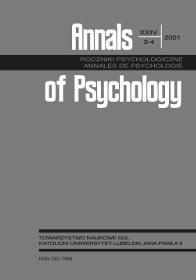What Do You Mean When You Say You Like This Painting? Oculomotor Indices of Processes Involved in Aesthetical Appreciation
What Do You Mean When You Say You Like This Painting? Oculomotor Indices of Processes Involved in Aesthetical Appreciation
Author(s): Piotr Francuz, Tomasz Jankowski, Paweł AugustynowiczSubject(s): Social Sciences, Psychology, Personality Psychology
Published by: Towarzystwo Naukowe KUL & Katolicki Uniwersytet Lubelski Jana Pawła II
Keywords: aesthetic evaluation; expertise in visual arts; figurative paintings; top-down control of eye movements; multilevel modeling
Summary/Abstract: This study aims to verify the hypotheses concerning emotional and cognitive predictors of aesthetic judgments, operationalized by instructions for viewing paintings from different perspectives (emotions and feelings, empathy, the captured moment, important elements, title, and mystery). Two eye movement parameters: fixation duration average and scan path length, estimated based on data recorded during viewing paintings, were analyzed. The extent to which the parameters of eye movement while performing different instructions predict the same parameters during the aesthetic assessment task was investigated. It was assumed that similar parameters of eye movements are indicators of similar mental processes, activated under different instructions. The viewing time window and expertise of participants were independent variables. Data were analyzed by multilevel modeling. The results showed that at the early stage of viewing a painting, instructions that activate emotional processing (regardless of expertise), better predict the aesthetic evaluation of a painting than instructions activating cognitive processes. At this stage, it was also found that the eye movement parameters, during the performance of instructions that activate cognitive processing, better predict the aesthetic evaluation of paintings only in the group trained in visual arts. At the later stage of viewing paintings, instructions activating cognitive processes turned out to be more reliable predictors of eye movement parameters during the aesthetic evaluation task than instructions activating emotional processes in both groups of participants. The results of the experiment were confronted with the existing models of perception of art and aesthetic experience.
Journal: Roczniki Psychologiczne
- Issue Year: 24/2021
- Issue No: 3-4
- Page Range: 201-226
- Page Count: 26
- Language: English

